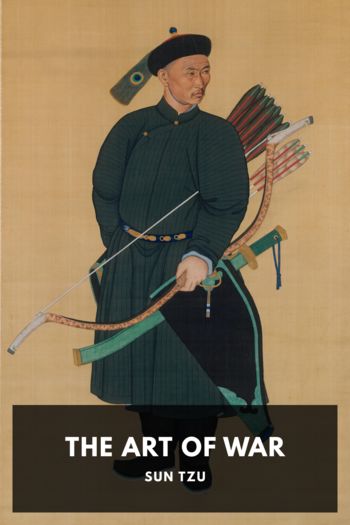The Art of War by Sun Tzu (elon musk reading list TXT) 📕

- Author: Sun Tzu
Book online «The Art of War by Sun Tzu (elon musk reading list TXT) 📕». Author Sun Tzu
Literally, “These five things are knowledge of the principle of victory.” ↩
Li Chʽüan cites the case of 苻堅 Fu Chien, prince of 秦 Chʽin, who in 383 AD marched with a vast army against the 晉 Chin Emperor. When warned not to despise an enemy who could command the services of such men as 謝安 Hsieh An and 桓沖 Huan Chʽung, he boastfully replied: “I have the population of eight provinces at my back, infantry and horsemen to the number of one million; why, they could dam up the Yangtsze River itself by merely throwing their whips into the stream. What danger have I to fear?” Nevertheless, his forces were soon after disastrously routed at the 淝 Fei River, and he was obliged to beat a hasty retreat. ↩
The modern text, represented by the 北堂書鈔 and Tʽu Shu, has 必敗, which I should be inclined to adopt in preference to 殆 here, though the Tʽung Tien and Yü Lan both have the latter. Chang Yü offers the best commentary on 知彼知己. He says that these words “have reference to attack and defence: knowing the enemy enables you to take the offensive, knowing yourself enables you to stand on the defensive.” He adds: 攻是守之機守是攻之策 “Attack is the secret of defence; defence is the planning of an attack.” It would be hard to find a better epitome of the root-principle of war. ↩
形 is a very comprehensive and somewhat vague term. Literally, “form,” “body,” it comes to mean “appearance,” “attitude” or “disposition;” and here it is best taken as something between, or perhaps combining, “tactics” and “disposition of troops.” Tsʽao Kung explains it as 軍之形也, 我動彼應兩敵相察情也 “marching and countermarching on the part of the two armies with a view to discovering each other’s condition.” Tu Mu says: “It is through the 形 dispositions of an army that its condition may be discovered. Conceal your dispositions (無形), and your condition will remain secret, which leads to victory; show your dispositions, and your condition will become patent, which leads to defeat.” Wang Hsi remarks that the good general can 變化其形因敵以制勝 “secure success by modifying his tactics to meet those of the enemy.” In the modern text, the title of the chapter appears as 軍形, which Capt. Calthrop incorrectly translates “the order of battle.” ↩
That is, of course, by a mistake on his part. Capt. Calthrop has: “The causes of defeat come from within; victory is born in the enemy’s camp,” which, though certainly an improvement on his previous attempt, is still incorrect. ↩
“By concealing the disposition of his troops, covering up his tracks, and taking unremitting precautions” (Chang Yü). ↩
The original text reads 使敵之可勝, which the modern text has further modified into 使敵之必可勝. Capt. Calthrop makes out the impossible meaning, “and further render the enemy incapable of victory.” ↩
Capt. Calthrop translates: “The conditions necessary for victory may be present, but they cannot always be obtained,” which is more or less unintelligible. ↩
For 不可勝 I retain the sense which it undoubtedly bears at the beginning of the chapter (“Sun Tzǔ said …” through “Thus the good fighter …”), in spite of the fact that the commentators are all against me. The meaning they give, “He who cannot conquer takes the defensive,” is plausible enough, but it is highly improbable that 勝 should suddenly become active in this way. An incorrect variant in the Yü Lan is 不可勝則守可勝則攻. ↩
Literally, “hides under the ninth earth,” which is a metaphor indicating the utmost secrecy and concealment, so that the enemy may not know his whereabouts. The 九地 of this passage have of course no connection with the 九地 “Nine situations” of chap. XI ↩
Another metaphor, implying that he falls on his adversary like a thunderbolt, against which there is no time to prepare. This is the opinion of most of the commentators, though Tsʽao Kung, followed by Tu Yu, explains 地 as the hills, rivers, and other natural features which will afford shelter or protection to the attacked, and 天 as the phases of weather which may be turned to account by the attacking party. Capt. Calthrop’s “The skilful in attack push to the topmost heaven” conveys no meaning at all. ↩
Capt. Calthrop draws on a fertile imagination for the following: “If these precepts be observed, victory is certain.” ↩
As Tsʽao Kung remarks, 當見未萌 “the thing is to see the plant before it has germinated,” to foresee the event before the action has begun. Li Chʽüan alludes to the story of Han Hsin who, when about to attack the vastly superior army of 趙 Chao, which was strongly entrenched in the city of 成安 Chʽêng-an, said to his officers: “Gentlemen, we are going to annihilate the enemy, and shall meet again at dinner.” The officers hardly took his words seriously, and gave a very dubious assent. But Han





Comments (0)